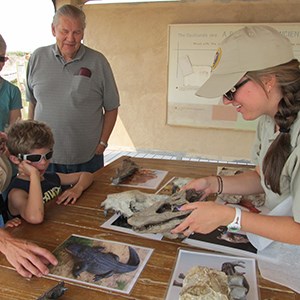Introduction

Education and outreach are vital in our efforts to promote good stewardship, better understanding of the places we manage, and buy-in as to the values these resources hold for the American public. Fossils discovered on the nation's public lands preserve ancient life from all major eras of Earth's history, and from every major group of animal or plant. In the national parks, for example, fossils range from primitive algae found high in the mountains of Glacier National Park, Montana, to the remains of ice-age animals found in caves at Grand Canyon National Park, Arizona. Public lands provide visitors with opportunities to interpret a fossil's ecological context by observing fossils in the same place those animals and plants lived millions of years ago.
Educational Materials About Paleontological Resources
The Paleontological Resources Preservation Act (2009) specifically addresses “Public Awareness and Education Programs” that increase public awareness about the significance of paleontological resources. The NPS Paleontology Program supports development and review of paleontological-resource-focused materials and media that promote understanding among various audiences (e.g., staff, public, other stakeholders).
Learn More
National Fossil Day
The NPS established the National Fossil Day partnership in 2010 to promote the scientific and education values of fossils. The partnership now includes more than 380 partners throughout the U.S. and in every state. National Fossil Day is celebrated annually on the Wednesday of the second full week in October, during Earth Science Week, and includes a theme highlighting a specific aspect of park paleontology.
Learn More
Last updated: August 19, 2022
